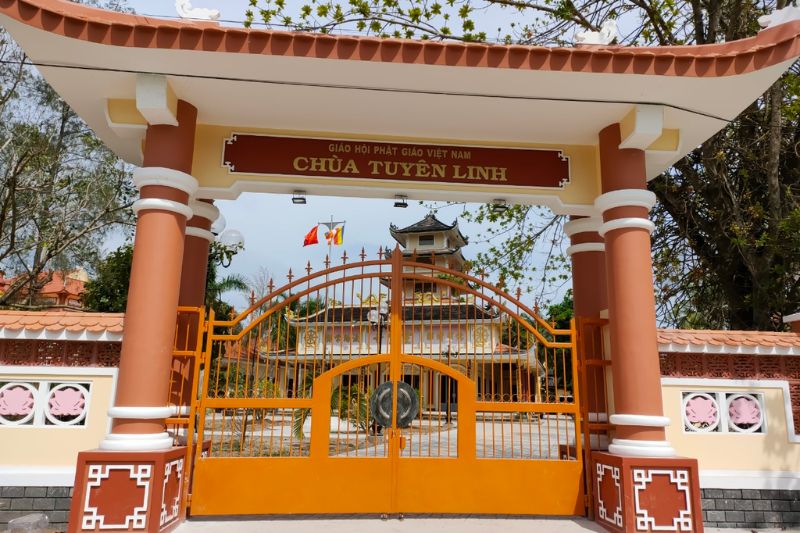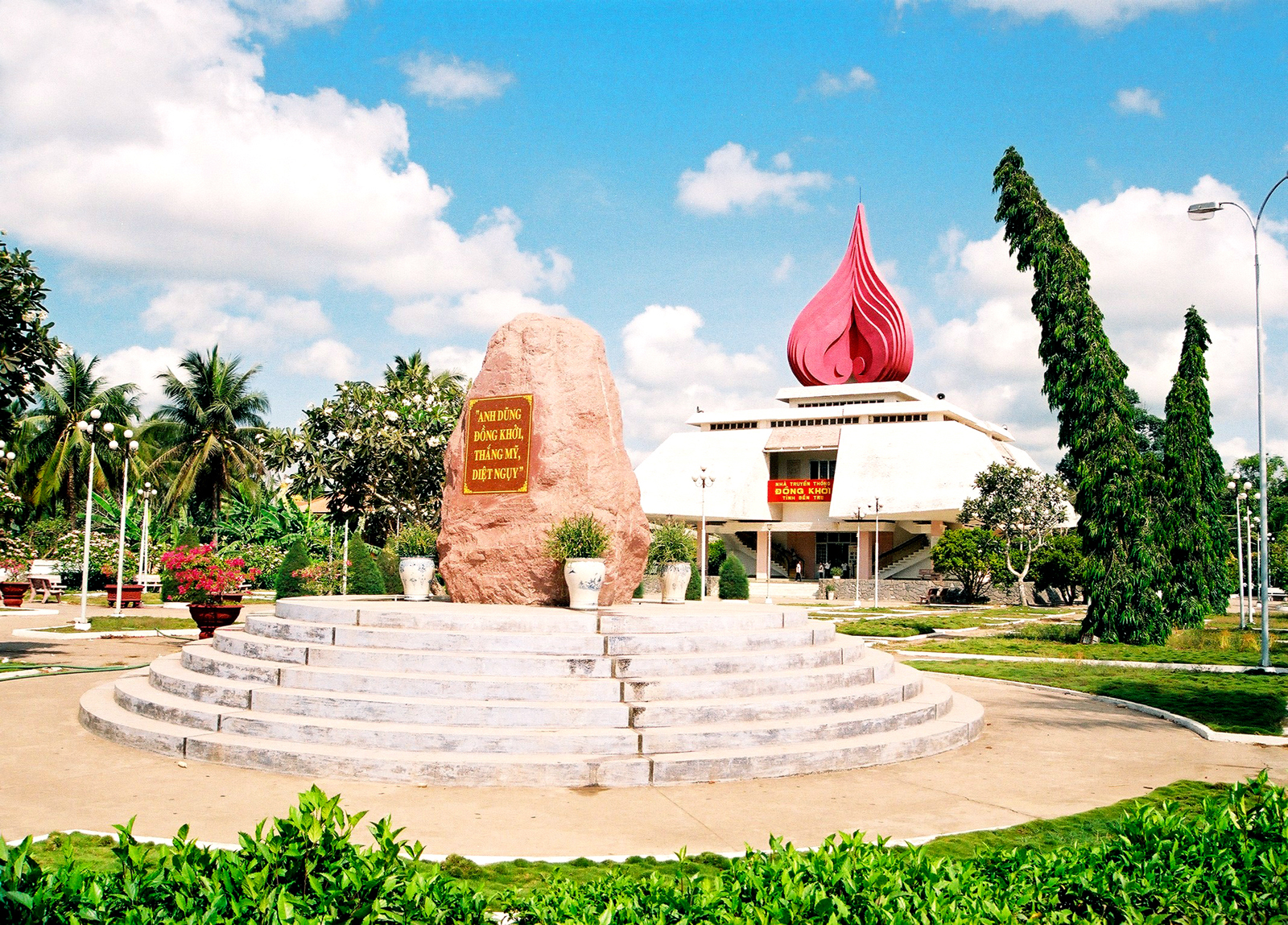Relic point Vietnam
Việt NamTuyen Linh Pagoda
Tuyen Linh Pagoda is located in Tan Thoi Dong B hamlet, Minh Duc commune, Mo Cay Nam district, Ben Tre province. Tuyen Linh Pagoda was built in the year of Tan Dau (1861), during the 14th year of Tu Duc's reign. At first, the pagoda was called Tien Linh, led by Venerable Khanh Phong and made of bamboo and leaves to worship Mrs. Sam - who was tiger pounces but very sacred. Tuyen Linh Pagoda is where Mr. Nguyen Sinh Sac, Uncle Ho's father, stopped many times to stay. The longest time Mr. Pho Bang stayed here was from 1927 to 1929. During his stay at the pagoda, Mr. Pho Bang opened teaching classes, checked pulses and made medicine for people in the area, and discussed matters with the Abbot. people, country affairs. In the years before Dong Khoi, Ben Tre was in the harsh grip of America and Diem. The Tan Huong - Minh Duc region, where Tuyen Linh pagoda is located, is still one of the places with the strongest development of the Revolutionary movement in the province. . The agencies of Mo Cay District Party Committee and Ben Tre Provincial Party Committee were once stationed at Tuyen Linh Pagoda with the help and concealment of the people and Buddhist followers during the Revolutionary period. During the two resistance wars, Tuyen Linh pagoda was a place to hide and nurture revolutionary cadres, so twice the enemy used planes to bomb, destroy and burn the pagoda. The pagoda was restored many times and was newly built in 1999 on the old, very spacious foundation. However, there are not many artifacts associated with the pagoda's past. In 1941 the Pagoda was repaired for the first time, and in 1983 the Pagoda continued to be repaired and expanded. In 1999, the pagoda was greatly restored on the old pagoda's foundation. The pagoda has a 0.7m high dharma guardian statue made of ancient bronze. The pagoda garden has stupas inscribed with the names of three Patriarchs: Venerable Khanh Phong (1823-1905), Zen Master Minh Bao (1846-1919) and Dharma Master Khanh Hoa (1877-1948). In 2003, the pagoda received a giant bell that was 1.7m tall and weighed over 330kg. On July 20, 1994, the Ministry of Culture and Information recognized Tuyen Linh Pagoda as a National Historical and Cultural Monument. Source: Compilation of Ben Tre province newspaper
Vinh Long 3823 view
Ben Tre Snake Temple
Snake Temple in Mo Cay, Ben Tre has long been a sacred place, because this place is associated with many legends about the snake god protecting people. Not only that, Dinh Ran is also the place where Hero of the Armed Forces Nguyen Thi Dinh - aka female general Ba Dinh - started the Dong Khoi movement. There is an anecdote that said that when Ms. Ba Dinh was pointed out by Viet traitors, it was the snake god in Dinh Ran who "protected" Ms. Ba, helping her escape from the enemy's vicious gun barrels... Snake Communal House, also known as Dinh Nhon Communal House, is located in Dinh Thuy commune, Mo Cay district, now Mo Cay Nam, Ben Tre province. Snake Communal House is located on a small, isolated road, with spindly eucalyptus trees planted on both sides of the road. According to the people here, in the early 18th century, the four families Nguyen, Phan, Trinh, and Vo were considered the ones who explored this land. This place used to be deserted, with few people and many wild animals. So, when they arrived in this land, the elders built a small temple to worship Mr. Ho. Not long after the temple was established, more and more residents in the area came to admire and worship. The village elders here recently asked to establish a village and named it Dinh Phuoc village. The small temple was built into Snake Communal House. It is called Snake Communal House because in the past there were many high mounds here where many snakes lived. Every time the day comes to worship the temple, the snake appears and disappears for a moment. The offering is left behind after the offering, then the snake comes and takes it away. Since then, the lives of people in the area have become better, crops have always been bountiful, and villagers have been healthy. In the past, in front of the communal house gate, there was a pair of big snakes. That pair of snakes did not harm the people in the area but only ate the meat of beasts, lobsters, and leopards. People in the area call it "Mr. and Mrs. Snake". After the day of national unification, that pair of snakes was no longer seen. In early 1960, Mrs. Nguyen Thi Dinh, known to coconut people as Ms. Ba Dinh, secretly together with the leaders of the Ben Tre Provincial Party Committee, went to Snake communal house to have a meeting to discuss Dong Khoi day. The news leaked out and reached the ears of the Republic of Vietnam regime. The Ngo family immediately sent an army led by a security lieutenant to ambush the Snake temple to capture the revolutionary soldiers. Many soldiers were afraid of the "Snake God" and did not dare to go. A bit confused, the Lieutenant carried a lot of grenades with him so that when he encountered the giant "Mr. and Mrs. Snake" he would blow them up. "My soul is broken", when I was almost able to capture Ms. Ba Dinh, suddenly a soldier screamed wildly, thinking he had seen "Mr. and Mrs. Snake". The soldier pulled out the grenade pin, intending to throw it to "Mr. and Mrs. Snake", but for some reason, he threw it back at his comrades. The soldiers were excited that the other soldier must have been possessed by the "Snake God". The Lieutenant Commander was also seriously injured and a few days later was bitten by a poisonous snake and died. Puppet soldiers attempted to sabotage Snake communal house. But because they were afraid to go near the communal house, they used bombs and grenades to destroy the sacred communal house. Although desolate and dilapidated, Snake Communal House is still a sacred land that surrounded revolutionary soldiers during the years of bloody and horrifying resistance. In 1993, the Ministry of Culture and Information recognized Snake communal house as a national historical and cultural relic. Source: Compilation of People's Electronic Newspaper
Vinh Long 6224 view
Dong Khoi Ben Tre Special National Monument
Dong Khoi Ben Tre relic belongs to Dinh Thuy commune, Mo Cay Nam district, Ben Tre province. The place where the historical event Dong Khoi Ben Tre took place, opening the Dong Khoi movement of the South Vietnamese revolution. In May 1959, the Party Central Committee held its 15th Conference to review the domestic situation and set out revolutionary guidelines for the whole country and the South, determining the basic task: Liberation of the South from imperialist rule, achieving national independence and the plowmen having their own fields, completing the people's national democratic revolution in the South, moving towards building a peaceful, unified, independent Vietnam. democracy and prosperity. In early December 1959, comrade Nguyen Thi Dinh - Deputy Secretary of the Ben Tre Provincial Party Committee held a meeting at Cu Lao Minh, the Ben Tre Provincial Party Committee selected 3 communes Dinh Thuy, Phuoc Hiep and Binh Khanh in Mo Cay district (now is Mo Cay Nam district) as the guiding base and the starting place of Dong Khoi. At 11:00 a.m. on January 12, 1960, in Dinh Thuy commune, all the people rose up and attacked the enemy. Opening the movement, on the morning of January 17, 1960, revolutionary forces arrested and executed Doi Ty - commander of the General Civil Guard, notorious for his cruelty. Next, the revolutionary forces and the masses surrounded Snake Communal House - where the Civil Guard General was stationed and surrounded and occupied Vam Nuoc station. Our forces captured the station and took control of the situation. Our troops captured 15 guns, 10 grenades and 1,000 bullets of all kinds, liberating all communes and hamlets in Dinh Thuy, puppets and soldiers in the area. rumors of disbandment. At 10:00 p.m. on January 17, 1960, when ordered to rebel, the people of Phuoc Hiep took to the streets to demonstrate their strength to support action groups besieging the civil guard station and the commune. Phuoc Hiep was engulfed in cheers, drums and the continuous explosion of pipes and loudspeakers calling for surrender. The people of Phuoc Hiep commune smashed the enemy's stranglehold, gaining mastery over the entire commune. On January 18, 1960, the people of Binh Khanh commune simultaneously stood up to defeat the hamlets, commune guards, spies and informers, and seized power. Because the puppet forces here were very strong, it was not until 12:00 midnight on January 20, 1960 that Binh Khanh commune was completely liberated. Following the direction of the province, people throughout Mo Cay district simultaneously rebelled, day and night; The continuous sound of drums and gongs spread throughout Cu Lao Minh and Cu Lao Bao. Young men and women were organized into teams, hoisting flags, carrying large guns and small guns with coconut palms, and dragging them like water bursting its banks to demonstrate revolutionary spirit, intimidate the enemy's spirit, making them lie down in fear. stay in the garrison. From Ben Tre, the Dong Khoi movement quickly spread throughout the Mekong Delta provinces. On the night of January 24 and early morning of January 25, 1960, many rural areas rose up to destroy evil, break the grip, disband communes and hamlets, and gain mastery. Until mid-1960, the Dong Khoi fire continued to spread to the Central Highlands provinces, creating a vibrant chain uprising throughout the Southern and Central Highlands provinces. Dong Khoi Traditional House was built in 2001, with a total area of 5,029.3m2, including main items: reception house, victory stele and traditional house. The reception house is built of reinforced concrete, has a pink ceramic tile floor, and a red tiled roof. The house has three doors made of iron frames painted gray and covered with glass, the main door facing East, two side doors facing South. The victory stele was built on the right side of the relic, consisting of seven concentric circular steps covered with blue polished stone. The front facing south is engraved with eight golden words "Heroes rise together, defeat the Americans and destroy the puppets". The back of the stele is engraved with the content "Miracle Fire" because Ben Tre province launched a contest to write an epitaph praising Dong Khoi in 1960, and was engraved on the stele to commemorate the 45th anniversary of Dong Khoi Ben Tre. The Traditional House has a ground floor and an upper floor, on the roof is a 12m high Dong Khoi torch symbol. The inside of the ground floor displays images, documents and artifacts of the political struggle movement of the people of Ben Tre from July 1954 to the end of 1959. The upper floor displays images, documents and artifacts from the Ben Tre people's political struggle. Dong Khoi movement. In the middle hall, there is a stylized wall embossed with the words "Heroes rise together, defeat the Americans and destroy the puppets", next to it is a sand table representing the Dong Khoi Ben Tre movement. Dong Khoi Ben Tre relic was ranked by the Prime Minister as a special national relic on December 22, 2016. Source: Department of Cultural Heritage
Vinh Long 6542 view




